7.8W LED system that reduces component count and eliminates LED flashing
One of the challenges of LED light designers is to create lighting systems that produce a constant light output without significant flicker. In systems using single-stage LED drivers, illumination without flicker is difficult to achieve because random distortion of the line voltage causes the LED current to be unstable and produce flicker. The circuit feedback response is usually the root cause of the problem because it may not react quickly enough to the distortion.
To solve this problem, we designed a 7.8W LED system and tested it using a power factor correction (PFC) control circuit. We found that the combination of the two - using internally generated sinusoidal references and discontinuous conduction mode (DCM) operation - can improve performance, reduce component count and eliminate flicker.
Internally generated digital sinusoidal reference
In most designs that use current mode operation to control the PFC, a sinusoidal reference is obtained by sensing the input voltage using a resistor divider. An internally generated sinusoidal reference that is generated using a digital map to make the LED current of the buck-boost topology more stable. The internally generated sinusoidal reference also eliminates the resistor divider, resulting in fewer component counts and a more compact design. Figure 1 provides a block diagram of the circuit.
Figure 1. LED driver configuration
The power supply voltage (Vcc) is supplied by a high voltage (HV) device built into the controller. Because the input voltage zero-crossing trigger is detected by the Vcc and HV blocks, the internal sinusoidal reference and the zero-crossing trigger signal are synchronized. The output signal from the on-chip digital-to-analog converter (DAC) produces a digital sinusoidal reference using internally mapped sinusoidal information and a synchronized zero-crossing trigger signal. When the Vcc voltage is less than 15.5V, the zero-crossing trigger detector (ZCD) has a low voltage and the DAC and internal clock automatically provide a digital reference signal with a digital step of 32 bits.
CRM and DCM operations
In converters that use a boost topology, the input current is configured by the inductor current. This optimizes the PFC in critical conduction mode (CRM) operation due to the presence of a constant on-time and variable off-time. On the other hand, due to the buck-boost topology, the input current is proportional to the switching current. As a result, the PFC is lowered in the CRM operation, and the line peak voltage becomes flatter. The input current is determined by the inductor current associated with the MOSFET turn-on. Equation 1 shows how to calculate the input current in a buck-boost converter.
(Equation 1)
Based on Equation 1, the input current is proportional to the input voltage by controlling the constant on-time and the constant switching period in the buck-boost converter. This means that the best mode is a discontinuous conduction mode (DCM) operation with a fixed on-time.
PZDK series of automatic constant current charge and discharge equipments are specially designed for the battery charging and discharging applied in railway. They are used for the maintenance and capacity verification of storage battery used in locomotive, railway vehicle and generator car, which can improve the service life of the battery and ensure the safe running of locomotives and other railway vehicles.
The main control unit of the equipment is PLC and the HMI (Human Machine Interface) is 7" LCD colorful touch screen. The equipment has varieties of operating modes, and can automatically record and save working status.

Battery Charging And Discharging Equipment
Railway Battery Charger,Charging And Discharging Device,Battery Charge Discharge Device,Electric Pallet Truck Battery Charger
Xinxiang Taihang Jiaxin Electric Tech Co., Ltd , https://www.chargers.be